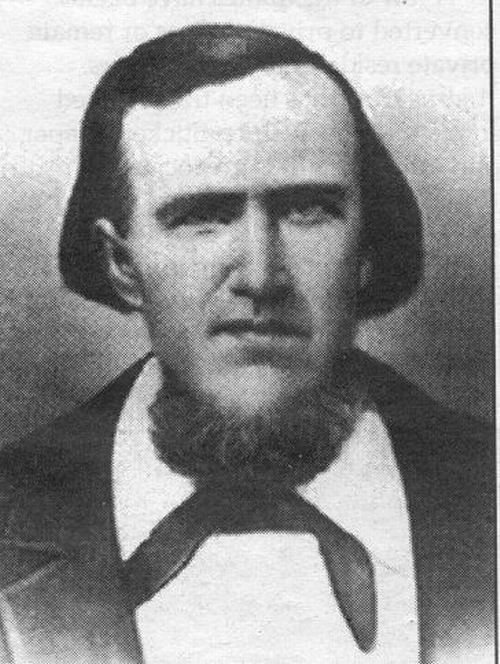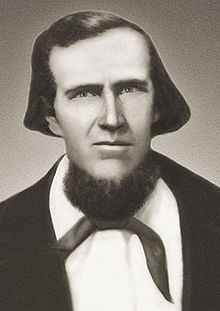
WASHINGTON COUNTY HISTORICAL SOCIETY (Washington County, Utah)
JACOB VERNON HAMBLIN
(pioneer, missionary)
BIOGRAPHY
Brigham Young gave Jacob Hamblin the title of the "Special Apostle among the Lamanites" in 1876. For the previous twenty years, Jacob had been working tirelessly to improve relations between the Native Americans and the settlers in the southwest of the United States. This title truly defines the life of this great Latter-day Saint leader.Jacob Vernon Hamblin was born April 2, 1819 in Salem, Ohio to Isaiah and Daphne Hamblin who parented 11 other children. From early on in his life Jacob cultivated a strong work ethic. When Jacob was nearly twenty years old he had a near death experience while he was working some land that he and his father had acquired in Wisconsin. He promised God that if his life were spared then Jacob would dedicate himself to serving Him for the rest of his mortal sojourn.
Jacob found love in 1839 when he married Lucinda Taylor in Spring Prairie, Wisconsin. They established a homestead in that small town and Jacob was convinced that he would live out his life in that place. But in 1842 he found religion through Lyman Stoddard, a Mormon missionary that had made his way to Spring Prairie. Against the wishes of his wife, Jacob subsequently was baptized into The Church of Jesus Christ of Latter-Day Saints. Lucinda tolerated Jacob's membership in the church for many years. She even was baptized into the church and also moved to Nauvoo with Jacob. But in 1849, when Jacob desired to move west with the rest of the Mormon pioneers, she refused to go and that proved to be the end of their marriage.
Eight months after Jacob left Lucinda he found a new companion, Rachel Judd, whom he married before his departure west. After his family arrived in the Salt Lake Valley, Brigham Young had them settle in Tooele, which is west of Salt Lake City. Jacob's first encounters with Native Americans came while his family lived in Tooele. On one such occasion a conflict arose in which Jacob tried to discharge his rifle but it wouldn't fire. Arrows shot by the Indians also grazed his clothes. Jacob surmised that there was divine intervention involved in this event so he vowed that he would never shed the blood of Indian.
In 1854, President Brigham Young called Jacob to serve a mission in Southern Utah. This was a pivotal point in his life because after this call he would be consumed by preaching the gospel to the Indians and improving the relationship between them and the Mormon Settlers. Eventually, Jacob would move his family to Santa Clara, UT, which was adjacent to the valley that would become St. George. Most of Jacob's missionary expeditions proved to be trying because of the nature and customs of the Indians.
During his time in Southern Utah, Jacob made many visits to the Indians near the Colorado River. He was able to cultivate a reputation of respect and kindness among the Native Americans. He had that same reputation among the Latter-Day saints. When Jacob was on his way to Salt Lake City to make a report to Brigham Young, he encountered the ill-fated Baker-Fancher party. He told them that they could take their cattle through Mountain Meadows, where he owned property, so that their cattle could graze. Jacob was deeply saddened when he heard the news of the Mountain Meadows Massacre. Almost twenty years later he testified against John D. Lee, who was executed for his involvement in the massacre.
There was a joyous event that also took place 1857, which was Jacob's marriage to Sarah Priscilla Leavitt. Eight years later he would marry Louisa Bonelli, who was an immigrant from Switzerland. The Hamblin family would relocate to Kanab, Utah in 1869. The time that Jacob spent in Kanab was highlighted by exploring the Colorado River, establishing trails in Southern Utah and of course keeping the peace among the Indians and settlers. The Navajo nation always seemed to be aggravated by the actions of the white settlers. In his negotiations with the Navajo tribe in 1870, Jacob and also John Wesley Powell, who was director of the US Geological Survey, entered into a peace treaty with the Navajos. This actually opened up trade between the white settlers and the Navajos.
Nearly a decade would pass before the Hamblin's would receive another call to settle a new area in the southwest. In 1878, Jacob took part of his family to live at Milligan's Fort in Northern Arizona. Their time in Milligan was filled with hardship because food was often scarce and there were always marauding Indians about.
By 1883, Jacob was advanced in age but was still doing all he could to serve the Indians. That year he was called to move his family again, this time to Pleasanton, New Mexico. This would prove to be Jacob's last move. For the next three years Jacob spent his time visiting old friends and evading US Marshals who had started arresting practicing polygamists. For this reason Jacob wasn't able to stay at home with his family for extended periods of time during his last years of life.
Fortunately for the Hamblin family they were able to be together right before Jacob's death. In August of 1886, Jacob contracted malaria and passed away in Pleasanton on the last day of the month. When the leaders of the LDS church heard the news of Jacob's passing they felt much sorrow because of the great contributions that Jacob made not only to the building up of the church but also the establishment of the great American Southwest. Jacob Hamblin was a true American pioneer!
FAMILY
|
Parents and Siblings:
Isaiah Hamblin Daphne Haynes Hamblin Melissa Daphne Hablin Emily Haynes Hamblin Jacob Vernon Hamblin Olive Haynes Hamblin Adeline Amarilla Hamblin Obed Hamblin Alson Haynes Hamblin William Haynes Hamblin Oscar Hamblin Edward Hamblin Francis Marion Hamblin Frederick Hamblin |
(6/20/1790-10/7/1856) (married 11/30/1812) (8/29/1797-8/29/1847) (2/1/1814-??/??/1855) (married Xxxxxxx X. Xxxxxxxx) (10/31/1817-7/4/1841) (married Xxxxxxx X. Xxxxxxxx) (4/6/1819-8/31/1886) (married Xxxxxxx X. Xxxxxxxx) (5/1/1821-7/9/1839) (married Xxxxxxx X. Xxxxxxxx) (9/18/1823-7/20/1895) (married Xxxxxxx X. Xxxxxxxx) (2/25/1826-??/??/1848) (married Xxxxxxx X. Xxxxxxxx) (4/28/1828-??/??/1863) (married Xxxxxxx X. Xxxxxxxx) (10/28/1831-5/8/1872) (married Xxxxxxx X. Xxxxxxxx) (4/4/1833-??/??/????) (married Xxxxxxx X. Xxxxxxxx) (5/20/1835-??/??/????) (married Xxxxxxx X. Xxxxxxxx) (11/27/1839-7/30/1881) (married Xxxxxxx X. Xxxxxxxx) (2/12/1841-11/8/1922) (married Xxxxxxx X. Xxxxxxxx) |
|
First Wife and Children: Lucinda Taylor Hamblin Duane Hamblin Martha Adaline Hamblin Maryette Magdaline Hamblin Lyman Stoddard Hamblin |
(8/24/1823-??/??/1858) (married 4/30/1839) (2/11/1841-??/??/1862) (married Xxxxxxx X. Xxxxxxxx) (9/15/1843-6/17/1877) (married Xxxxxxx X. Xxxxxxxx) (5/17/1845-??/??/1910) (married Xxxxxxx X. Xxxxxxxx) (3/11/1848-9/23/1923) (married Xxxxxxx X. Xxxxxxxx) |
|
Second Wife and Children: Rachel Judd Hamblinn Lois Hamblin Joseph Hamblin Rachel Tamar Hamblin Benjamin Hamblin Arminda Hamblin Adopted Native Americans Albert Hamblin Susan Hamblin Ellen Hamblin |
(9/15/1821-2/18/1865) (married 9/30/1849) (6/15/1851-8/30/1891) (married Hubert Roselle Burk) (10/6/1854-12/3/1924) (married Elsie Albertine Johnson) (8/31/1856-3/17/1877) (married William Thomas Stewart) (9/29/1858-9/27/1930) (married Della Jane Brown) (1/27/1861-??/??/1862) (??/??/1841-3/??/1863) (married Xxxxxxx X. Xxxxxxxx) (??/??/1854-??/??/1862) (??/??/????-??/??/????) (married Xxxxxxx X. Xxxxxxxx) |
|
Third Wife and Children: Sarah Priscilla Leavitt Hamblin Sarah Olive Hamblin Melissa Hamblin Lucy Hamblin Jacob Hamblin Ella Ann Hamblin Mary Elizabeth Hamblin Clara Melvina Hamblin Dudley Jabez Hamblin Don Carlos Hamblin |
(5/8/1841-7/23/1927) (married 9/11/1857) (10/10/1858-6/30/1919) (married Xxxxxxx X. Xxxxxxxx) (4/25/1861-5/9/1933) (married Xxxxxxx X. Xxxxxxxx) (5/11/1863-12/28/1871) (3/21/1865-4/1/1939) (married Xxxxxxx X. Xxxxxxxx) (6/11/1867-3/21/1947) (married Xxxxxxx X. Xxxxxxxx) (9/25/1872-5/12/1959) (married Xxxxxxx X. Xxxxxxxx) (11/5/1876-6/27/1959) (married Xxxxxxx X. Xxxxxxxx) (5/5/1880-??/??/????) (married Xxxxxxx X. Xxxxxxxx) (2/16/1882-11/15/1941) (married Xxxxxxx X. Xxxxxxxx) |
|
Fourth Wife: Eliza Hamblin (Paiute Indian) |
(??/??/????-??/??/????) (married 2/14/1863) |
|
Fifth Wife and Children: Louisa Bonelli Hamblin Walter Eugene Hamblin Inez Louisa Hamblin George Oscar Hamblin Alice Edna Hamblin Willard Otto Hamblin Amerilla Hamblin |
(10/29/1843-12/11/1931) (married 11/16/1865) (4/15/1868-1/22/1950) (married Xxxxxxx X. Xxxxxxxx) (4/4/1871-3/4/1932) (married Xxxxxxx X. Xxxxxxxx) (3/25/1873-9/1/1936) (married Xxxxxxx X. Xxxxxxxx) (2/3/1876-3/1/1902) (married Xxxxxxx X. Xxxxxxxx) (3/25/1881-??/??/????) (married Xxxxxxx X. Xxxxxxxx) (5/4/1884-??/??/1976) (married Xxxxxxx X. Xxxxxxxx) |
PHOTOS

|

|
REFERENCES
Record of the life of Jacob Hamblin as recorded by himselfAn autobiography in his own handwriting
Jacob Hamblin
A Narrative of his Personal Experience, As a Frontiersman, Missionary to the Indians and Explorer
Disclosing
Interpositions of Providence, Severe Privations, Perilous Situations and Remarkable Escapes.
Fifth Book of the Faith-Promoting Series
by James A. Little
Designed for the Instruction and Encouragement of Young Latter-day Saints
Juvenile Instructor Office, Salt Lake City, Utah, 1881
Biography of Jacob Hamblin
Friend and Brother
by Marlene Bateman Sulllivan
Ensign, October 1984
Indian Sketches from the Journals of T. D. Brown and Jacob Hamblin
by Juanita Brooks
Utah Historical Quarterly, Volume 29, Number 4, October 1961, pp. 347-360
Jacob Hamblin: His Own Story
by Hartt Wixom, Dixie College
A biography.
November 7, 1998
Jacob Hamblin: His Own Story
by Hartt Wixom
15th Juanita Brooks Lecture, November 7, 1998
Jacob Hamblin Peacemaker
Book by Pearson H. Corbett
Salt Lake City: Deseret Book Company, 1952.
Our Golden Heritage: The Duane and Addie Noble Hamblin Family
Book by Lois Hamblin Golding and Delma Golding Johnson.
Privately published, 1977.
"In & through the roughefist country it has ever been my lot to travel":
Jacob Hamblin's 1858 Expedition Across Colorado
by Todd M. Compton
Utah Historical Quarterly (UHQ), Volume 80, Number 1 (Winter 2012)
Pages 4-21
A Frontier Life: Jacob Hamblin, Explorer and Indian Missionary
Book by Todd M. Compton
University of Utah Press; 1st Edition edition (September 15, 2013)
624 pages
Rachel Judd Hamblin: One of God's Angels
By Frank F. Judd, Ph.D.
August 2023
See the information page.
My Great, Greats in Washington County 1854-1863: A Talk by Ron Bracken
Stories about Jacob Hamblin start at 3:53 into the 58-minute talk.
FamilySearch entry for Jacob Hamblin
Find-A-Grave entry for Jacob Vernon Hamblin Sr.
FamilySearch entry for Lucinda Taylor
Find-A-Grave entry for Lucinda Taylor Hamblin
FamilySearch entry for Rachel Judd
Find-A-Grave entry for Rachel Judd Hamblin
FamilySearch entry for Sarah Priscilla Leavitt
Find-A-Grave entry for Sarah Priscilla Leavitt Hamblin
FamilySearch entry for Eliza of the Shivwits Tribe
FamilySearch entry for Louisa Bonelli
Find-A-Grave entry for Louisa Bonelli Hamblin